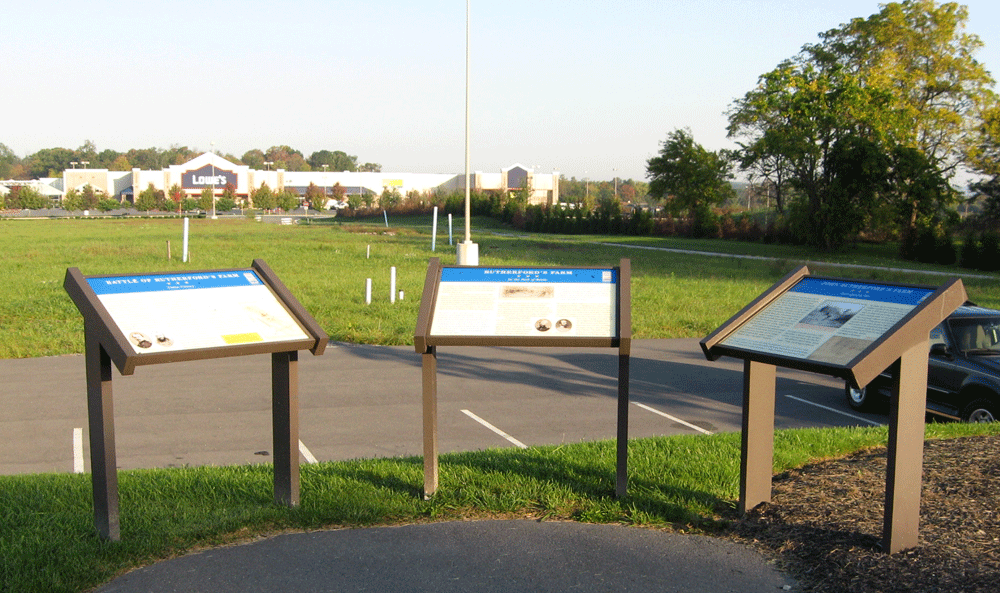The John Rutherford’s Farm – Interrupted by War wayside marker is the second of a set of six on Rutherford’s Farm northeast of Wnchester, Virginia. They have been relocated to a small park due to highway and land development.

From the marker:
John Rutherford’s Farm
Interrupted by War
John H. Rutherford was born about 1820. He acquired approximately 275 acres here between 1843 and 1848 from the heirs of John Carter. About May 24, 1849, Rutherford married Camilla C. Baker. At first, the couple lived with Mrs. Susan Pitman Carter, a widow and sister-in-law of John Carter, whose large brick house stood just north of here on her adjoining 173-acre farm. Her farm produced wheat, corn, Irish potatoes, and hay. In 1850, she owned 8 horses, 8 head of cattle, 2 oxen, 2 sheep that provided 125 pounds of wool, and 33 hogs. She also owned at least 7 slaves. Rutherford, who owned one horse at the time, evidently managed the Carter farm as well as his own.
By 1857, Rutherford was prosperous enough to construct a two-story brick house for his family. It stood just to your right, near the turnpike. Besides his wife and their children—Susan E., William, B., John C., and Albert G. Rutherford, who ranged in age from ten to two in 1860—Mary Spence, a domestic worker, and James Lownsan, a free black laborer, also lived here.
John Rutherford owned 9 horses, 10 head of cattle, 17 sheep, and 22 hogs just before the war began. He also raised wheat, oats, corn, Irish potatoes, and hay on his diversified farm. After the war, in 1870, he owned 5 horses, 13 head of cattle, no sheep, and only 2 hogs. His wheat production remained stable, but his corn and oat crops were greatly reduced. By 1890, Rutherford was essentially a sheep farmer, with 120 sheep and some other livestock. He died in 1900. Rutherford’s farmhouse was demolished about 1963.
Archaeological studies here have uncovered remains of the Rutherford house site, the Battle of Rutherford’s Farm, and the Third Battle of Winchester.
“It was a sad sight to see our poor men lying on the ground, with only a little straw under them, although I suppose there was never a battle field where there were so many alleviations, in the way of kindness & attention from women.”
– Mary Greenhow Lee, diary, July 23, 1864
From the caption to the photo at the top:
John Rutherford’s brick farmhouse ca. March, 1961, looking south, with Messick Children (from left to right) Roy R. Jr., Marvin L., Roger D., Steven R. (bottom) and Sidney W. (top).
Courtesy Karen Messick and Mrs. Roy R. Messick, Sr.
From the caption to the map:
Winchester area, 1864
Courtesy Library of Congress

The marker is one of three wayside markers relocated to a small park east of the Rutherford Crossing shopping center
